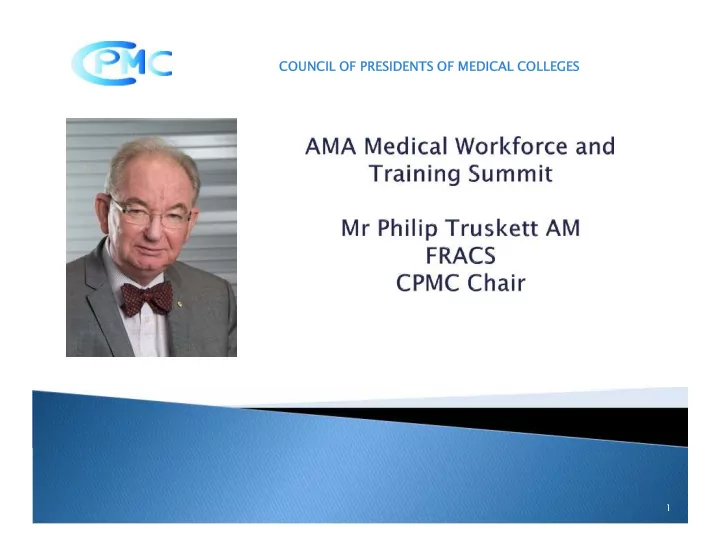

COUNCIL OF PRESIDENTS OF MEDICAL COLLEGES 1
CPMC is the unifying organisation for all fifteen specialist medical colleges, half of which are located also in NZ. Overview of current environment Recommend breaking down barriers • Discuss benefits of generalists v sub- specialisation • Incentivise for better geographic distribution 2
• We recognise over supply medical graduates • Demand for internships – is there capacity? • Competitive entry to vocational training • Large cohort of non hospital specialists wanting access • Complex workforce environment, problems at every part of the pipeline • Recommend breaking down barriers • Incentivise for better geographic distribution • Specialty versus sub-specialty- discuss • Be innovative and flexible 3
Source: Australia’s Future Health Workforce p9 Standard training pipeline if smooth access. • Non vocational trainees are growing – CMOs/NHS • Retirement age extending – no incentive to retire • Post Fellowship trainees remain in posts • Lack of consultant positions apparent • 4
Source: Dept Health with permission 5
Aggregate over supply projected to 2030 We know: Shortages persist in regions, in disciplines of increasing need: • geriatrics, psychiatry, urology, ENT, dermatology, palliative care Changing patterns of disease, chronicity and ageing • Population disease profile not matched with workforce, but • evidence is available Oversupply in ED, ICU, cardiology • Emerging in anaesthetics, obstetrics • We Need to lessen the rigidity of training process Targeted WF planning to include disease profile in region. • New & innovative methods of training- complex • 6
10 20 30 40 50 60 70 0 Timor Leste 0.9 1.1 1.6 2.3 2.5 3.2 5.7 Myanmar Samoa PNG Solomon Islands Vanuatu Fiji Micronesia 7 Tonga 14 Cook Islands 22 Nauru 30 New Zealand 43 Australia 64
Rural/regional Australians lack access to adequate medical care Early exposure to rural practice benefits UG, PG & consultants ◦ Radiologists /pathologists benefit from M&Ms Funding required for rural placements Better utilisation of the private sector ◦ Positive impact on patient outcomes 8
Maldistribution Employed medical practitioners: FTE per 100,000 population: principal area of practice, remoteness area, 2015 Source AIHW 2015 9
Develop the IRTP hubs + match with available infrastructure & increase it, ensure adequate supervision, provide pastoral care/support Integrated training & networking – obstetric diploma GP Rotational training to conditions have proven to be labour intensive + costly 10
Are we training for the main game? ◦ Generalism v sub-specialisation ◦ Too much focus on sub-specialty training ◦ Are we producing too many medical graduates – diluting training experience Can we be innovative? • Training hubs – graduates • Post fellowship experience • Incentives – infrastructure support. 11
Thankyou from Australia’s College Presidents 12
Recommend
More recommend